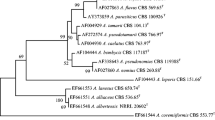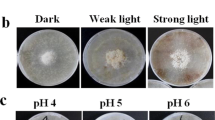Abstract
Penicillium thomii PT95 strain is able to form abundant orange, sand-shaped sclerotia in which carotenoids accumulate. We have studied the effects of copper (Cu)-induced oxidative stress on sclerotial differentiation, biosynthesis of some endogenous antioxidants, and activities of a number of the antioxidative enzymes of strain PT95. The association between sclerotial biomass, carotenoid, ascorbate and glutathione contents, and the activities of superoxide dismutase (SOD), catalase (CAT), ascorbate peroxidase (APX), and glutathione reductases (GR) were also analyzed in this fungal strain. We found that the oxidative stress induced by Cu was directly dependent on the concentrations of CuSO4 in the media, with higher CuSO4 concentrations resulting in higher oxidative stress. Cu-induced oxidative stress in strain PT95 was characterized by the initiation of lipid peroxidation. Under Cu-induced oxidative stress growth conditions, the initiation of exudates and sclerotia in strain PT95, as well as sclerotial maturation, were advanced by 1−2 days. Cu-induced oxidative stress favored sclerotial differentiation and the biosynthesis of endogenous antioxidants, i.e., carotenoids, ascorbate, and glutathione. Comparison of SOD, CAT, and GR activities at 0 and 100 μg/ml Cu revealed a 1.1-, 1.8-, and 1.2-fold increase, respectively, at the higher Cu concentration; comparison of their activities at 100 and 300 μg/ml Cu revealed a 1.4-, 3.1-, and 2.2-fold decrease, respectively, at the higher Cu concentration. APX activity decreased linearly with increasing CuSO4 concentration. Our results suggest that the ability of the P. thomii PT95 strain to cope with metal stress is related to its ability to trigger an efficient defense against oxidative stress. These findings may contribute to a better understanding of the response mechanisms of sclerotia production in Penicillium strains to metal stress and to better insights into metal–fungi interactions in natural environments.






Similar content being viewed by others
References
Asada K (1992) Ascorbate peroxidase: a hydrogen peroxide-scavenging enzyme in plants. Physiol Plant 85:235–241
Asada K (2006) Production and scavenging of reactive oxygen species in chloroplasts and their functions. Plant Physiol 141:391–396
Bai Z, Harvey LM, McNeil B (2003) Oxidative stress in submerged cultures of fungi. Crit Rev Biotechnol 23:267–302
Baldrian P (2003) Interactions of heavy metals with white–rot fungi. Enzyme Microb Technol 32:78–91
Blaudez D, Botton B, Chalot M (2000) Cadmium uptake and subcellular compartmentation in the ectomycorrhizal fungus Paxillus involutus. Microbiology 146:1109–1117
Borkow G, Gabbay J (2005) Copper as a biocidal tool. Curr Med Chem 12(18):2163–2175
Boscolo PRS, Menossi M, Jorge RA (2003) Aluminum induced oxidative stress in maize. Phytochemistry 62:181–189
Brady D, Glaum D, Duncan JR (1994) Copper tolerance in Saccharomyces cerevisiae. Lett Appl Microbiol 18:245–250
Burton WG, Ingold UK (1984) β-carotene: an unusual type of lipid antioxidant. Science 224(4649):569–573
Chillappagari S, Seubert A, Trip H, Kuipers OP, Marahiel MA, Miethke M (2010) Copper stress affects iron homeostasis by destabilizing iron–sulfur cluster formation in Bacillus subtilis. J Bacteriol 192(10):2512–2524
Dávila Costa JS, Albarracín VH, Abate CM (2011) Responses of environmental Amycolatopsis strains to copper stress. Ecotoxicol Environ Saf 74(7):2020–2028
Dupont CL, Grass G, Rensing C (2011) Copper toxicity and the origin of bacterial resistance—new insights and applications. Metallomics 3(11):1109–1118
Elleuch A, Chaâbene Z, Grubb Douglas C, Drira N, Mejdoub H, Khemakhem B (2013) Morphological and biochemical behavior of fenugreek (Trigonella foenum–graecum) under copper stress. Ecotoxicol Environ Saf 98:46–53
Esterbauer H, Schaur JR, Zollner H (1991) Chemistry and biochemistry of 4-hydroxynonenal, malonadehyde and related aldehydes. Free Radic Biol Med 11(1):81–128
Fatima RA, Ahmad M (2005) Certain antioxidant enzymes of Allium cepa as biomarkers for the detection of toxic heavy metals in waste water. Sci Total Environ 346:256–273
Fujs S, Gazdag Z, Poljšak B, Stibilj V, Milačič R, Pesti M (2005) The oxidative stress response of the yeast Candida intermedia to copper, zinc, and selenium exposure. J Basic Microbiol 45:125–135
Gadd GM (1993) Interactions of fungi with toxic metals. New Phytol 124:25–60
Georgiou CD (1997) Lipid peroxidation in Sclerotium rolfsii: a new look into the mechanism of sclerotial biogenesis in fungi. Mycol Res 101(4):460–464
Georgiou CD, Petropoulou KP (2001a) Role of erythroascorbate and ascorbate in sclerotial differentiation in Sclerotinia sclerotiorum. Mycol Res 105(11):1364–1370
Georgiou CD, Petropoulou KP (2001b) The role of ascorbic acid in the differentiation of sclerotia in Sclerotinia minor. Mycopathologia 154(2):71–77
Georgiou CD, Petropoulou KP (2001c) Effect of the antioxidant ascorbic acid on sclerotial differentiation in Rhizoctonia solani. Plant Pathol 50(5):594–600
Georgiou CD, Tairis N, Polycratis A (2001a) Production of β-carotene by Sclerotinia sclerotiorum and its role in sclerotium differentiation. Mycol Res 105(9):1110–1115
Georgiou CD, Zervoudakis G, Tairis N, Kornaros M (2001b) β-Carotene production and its role in sclerotial differentiation of Sclerotium rolfsii. Fungal Genet Biol 34(1):11–20
Georgiou CD, Zervoudakis G, Petropoulou PK (2003) Ascorbic acid might play a role in sclerotial differentiation of Sclerotium rolfsii. Mycologia 95(2):308–316
Giannopolitis CN, Ries SK (1977) Superoxide dismutases: I. occurrence in higher plants. Plant Physiol 59(2):309–314
Gokhale NH, Cowan JA (2005) Inactivation of human angiotensin converting enzyme by copper peptide complexes containing ATCUN motifs. Chem Commun (Camb) 47(47):5916–5918
Gratão PL, Polle A, Lea PJ, Azevedo RA (2005) Making the life of heavy metal- stressed plants a little easier. Funct Plant Biol 32:481–494
Griffith OW (1980) Determination of glutathione and glutathione disulfide using glutathione reductase and 2-vinylpyridine. Anal Biochem 106:207–212
Guillén Y, Machuca Á (2008) The effect of copper on the growth of wood–rotting fungi and a blue–stain fungus. World J Microbiol Biotechnol 24(1):31–37
Han JR (1998) Sclerotia growth and carotenoid production of Penicillium sp. PT95 during solid-state fermentation of corn meal. Biotechnol Lett 20(11):1063–1065
Han JR, Wang XJ, Yuan XE (1998) Studies on the production of carotenoids in sclerotia of PT95 strain of Penicillium. Microbiology 25(6):319–321 (In Chinese)
Han JR, Zhao WJ, Gao YY, Yuan JM (2005) Effect of oxidative stress and exogenous β-carotene on sclerotial differentiation and carotenoid yield of Penicillium sp. PT95. Lett Appl Microbiol 40(6):412–417
Hayashi Y, Mutoh N (1994a) Cadystin (phytochelatin) in fungi. In: Winkelmann G, Winge DR (eds) Metal ions in fungi. Marcel Dekker, New York, pp 339–359
Hayashi Y, Mutoh N (1994b) Cadystin (phytochelatin) in fungi. In: Winkelmann G, Winge DR (eds) Metal ions in fungi. Marcel Dekker, New York, pp 311–337
Hodges MD, DeLong JM, Forney CF, Prange RK (1999) Improving the thiobarbituric acid-reactive substances assay for estimating lipid peroxidation in plant tissues containing anthocyanin and other interfering compounds. Planta 207(4):604–611
Jamieson DJ (1998) Oxidative stress responses of the yeast Saccharomyces cerevisiae. Yeast 14:1511–1527
Joho M, Inouhe M, Tohoyama H, Murayama T (1995) Nickel resistance mechanisms in yeasts and other fungi. J Ind Microbiol 14:164–168
Krumova EZ, Pashova SB, Dolashka–Angelova PA, Stefanova T, Angelova MB (2009) Biomarkers of oxidative stress in the fungal strain Humicola lutea under copper exposure. Process Biochem 44(3):288–295
Krumova ET, Stoitsova SR, Paunova-Krasteva TS, Pashova SB, Angelova MB (2012) Copper stress and filamentous fungus Humicola lutea 103—ultrastructural changes and activities of key metabolic enzymes. Can J Microbio 58(12):1335–1343
Li LJ, Liu XM, Guo YP, Ma EB (2005) Activity of the enzymes of the antioxidative system in cadmium–treated Oxya chinensis (Orthoptera Acridoidae). Environ Toxicol Pharmacol 20(3):412–416
Li XL, Cui XH, Han JR (2006) Sclerotial biomass and carotenoid yield of Penicillium sp. PT95 under oxidative growth conditions and in the presence of antioxidant ascorbic acid. J Appl Microbiol 101(3):725–731
Martino E, Franco B, Piccoli G, Stocchi V, Perotto S (2002) Influence of zinc ions on protein secretion in a heavy metal tolerant strain of the ericoid mycorrhizal fungus Oidiodendron maius. Mol Cell Biochem 231:179–185
McKersie BD, Leshem YY (1994) Oxidative stress. In: McKersie BD, Leshem YY (eds) Stress and stress coping in cultivated plants. Kluwer, Dordrecht, pp 15–54
Merian E (1991) Metals and their compounds in the environment. VCH Verlag, Weinheim
Mohr H, Schopfer P (1995) Plant physiology. Springer, Berlin
Mukherjee A, Das D, Mondal SK, Biswas R, Das TK, Boujedaini N, Khuda–Bukhsh AR (2010) Tolerance of arsenate–induced stress in Aspergillus niger, a possible candidate for bioremediation. Ecotoxicol Environ Saf 73:172–182
Nakano Y, Asada K (1981) Hydrogen peroxide is scavenged by ascorbate-specific peroxidase in spinach chloroplasts. Plant Cell Physiol 22(5):867–880
Navari–Izzo F, Meneguzzo S, Loggini B, Vazzana C, Sgherri CLM (1997) The role of the glutathione system during dehydration of Boea hygroscopica. Physiol Plant 99:23–30
Noctor G, Foyer CH (1998) Ascorbate and glutathione: keeping active oxygen under control. Annu Rev Plant Biol 49:249–279
Peña MMO, Lee J, Thiele DJ (1999) A delicate balance: homeostatic control of copper uptake and distribution. J Nutr 129(7):1251–1260
Pitt JI (2000) A laboratory guide to common Penicillium species, 3rd edn. CSIRO Division of Food Processing, North Ryde
Pócsi I, Prade RA, Penninckx J (2004) Glutathione altruistic metabolite in fungi. Adv Microbial Physiol 49:1–76
Radic S, Babic M, Skobic D, Roje V, Pevalek–Kozlina B (2010) Ecotoxicological effects of aluminum and zinc on growth and antioxidants in Lemna minor L. Ecotoxicol Environ Saf 73:336–342
Ray AA (1985) SAS users guide: statistics. SAS Institute, Cary
Rizzo DM, Blanchette RA, Palmer MA (1992) Biosorption of metal ions by Armillaria rhizomorphs. Can J Bot 70:1515–1520
Romero–Isart N, Vašák M (2002) Advances in the structure and chemistry of metallothioneins. J Inorg Biochem 88:388–396
Schraudner M, Langebartels J, Sandermann H (1997) Changes in the biochemical status of plant cell induced by the environmental pollutant ozone. Physiol Plant 100(2):274–280
Sharma SS, Dietz KJ (2009) The relationship between metal toxicity and cellular redox imbalance. Trends Plant Sci 14(1):43–50
Simic GM (1992) Carotenoid free radicals. In: Packer L (ed) Methods in enzymology. Academic, New York, pp 444–453
Stratton PS, Liebler DC (1997) Determination of singlet oxygen-specific versus radical-mediated lipid peroxidation in photosensitized oxidation of lipid bilayers: Effect of β-carotene and α-tocopherol. Biochemistry 36(42):12911–12920
Sun HS, Wang HN, Wang YY (2007) Study on activities of glutathione reductase in the haemolymph of Chlamys farreri. Mar Sci Bull 26:108–112
Suresh K, Subramanyam C (1996) Isolation and characterization of a copper containing protein from blue cell walls of Neurospora crassa. Indian J Exp Biol 34:671–677
Thounaojam TC, Panda P, Mazumdar P, Kumar D, Sharma GD, Sahoo L (2012) Excess copper induced oxidative stress and response of antioxidants in rice. Plant Physiol Biochem 53:33–39
Uauy R, Olivares M, Gonzalez M (1998) Essentiality of copper in humans. Am J Clin Nutr 67[Suppl]:952S–959S
Wang S, Teng S, Fan M (2010) Interaction between heavy metals and aerobic granular sludge. In: Santosh Kumar Sarkar (ed) Environmental management. Sciyo, Croatia, pp 173–188
Willekens H, Chamnongpol S, Davey M, Schraudner M, Langebartels C, Van Montagu M, Inzé D, Van Camp W (1997) Catalase is a sink for H2O2 and is indispensable for stress defence in C-3 plants. EMBO J 16:4806–4816
Yamamoto Y, Kobayashi Y, Devi SR, Rikiishi S, Matsumoto H (2002) Aluminum toxicity is associated with mitochondrial dysfunction and the production of reactive oxygen species in plant cells. Plant Physiol 128:63–72
Yazdanpanah M, Luo XP, Lau R, Greenberg M, Fisher LJ, Lehotay DC (1997) Cytotoxic aldehydes as possible markers for childhood cancer. Free Radic Biol Med 23(6):870–878
Zervoudakis G, Tairis N, Salahas G, Georgiou CD (2003) β-Carotene production and sclerotial differentiation in Sclerotinia minor. Mycol Res 107(5):624–631
Acknowledgments
Support for this research by the Chinese National Natural Science Fund (grant no. 31070048) is gratefully acknowledged.
Author information
Authors and Affiliations
Corresponding author
Rights and permissions
About this article
Cite this article
Zhao, W., Han, J. & Long, D. Effect of copper−induced oxidative stress on sclerotial differentiation, endogenous antioxidant contents, and antioxidative enzyme activities of Penicillium thomii PT95. Ann Microbiol 65, 1505–1514 (2015). https://doi.org/10.1007/s13213-014-0989-6
Received:
Accepted:
Published:
Issue Date:
DOI: https://doi.org/10.1007/s13213-014-0989-6




